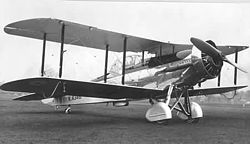Westland Wallace
| Westland Wallace | |
|---|---|

|
|
| Type: | Multipurpose aircraft and light day bomber |
| Design country: | |
| Manufacturer: | |
| First flight: |
October 31, 1931 |
| Commissioning: |
1933 |
| Production time: |
1933-1936 |
| Number of pieces: |
104 |
The Westland Wallace was built as a derivative of the Wapiti for the Royal Air Force Special Reserve (later Auxiliary Air Force ) and only flown by the AAF and AA Co-Operation Flight. Only later was the type also used for target tow plows.
When the Second World War broke out, 83 of the 104 Wallace Mk.IIs were still in service. Two specially converted Wallace's were the first aircraft to fly over Mount Everest .
production
Approval of the Westland Wallace by the RAF:
| version | 1933 | 1934 | 1935 | 1936 | total |
|---|---|---|---|---|---|
| prototype | 1 | 1 | |||
| Mk.I, conversion | (26) | (19) | (12) | (57) | |
| Mk.I, new building | 8th | 1 | 9 | ||
| Mk.II, conversion | (3) | (3) | |||
| Mk.II, new build | 1 | 93 | 94 | ||
| total | 1 | 8th | 1 | 93 | 103 |
The conversion was made from Westland Wapiti.
Technical specifications
| Parameter | Data |
|---|---|
| crew | 2 |
| length | 10.41 m |
| span | 14.15 m |
| height | 3.51 m |
| Wing area | 45.34 m² |
| Empty mass | 1742 kg |
| Max. Takeoff mass | 2608 kg |
| Cruising speed | 217 km / h |
| Top speed | 254 km / h at an altitude of 4570 m |
| Service ceiling | 7435 m |
| Range | 756 km |
| Engines | 1 × Bristol Pegasus IV radial engine with 507 kW (690 PS) |
| Armament | 2 7.7 mm MG , up to 263 kg bombs as external load |
See also
Individual evidence
- ↑ Halley, James J .: The K File. The Royal Air Force of the 1930s , Tunbridge Wells, 1995, p. 389 ff.